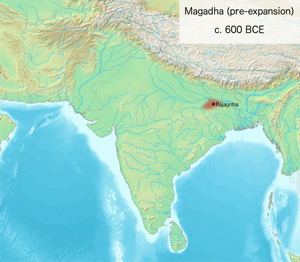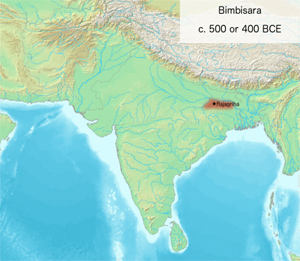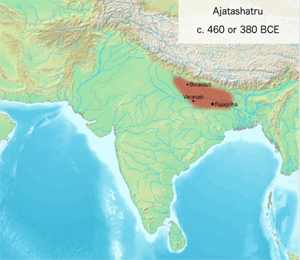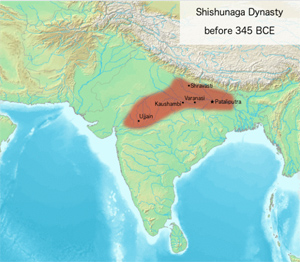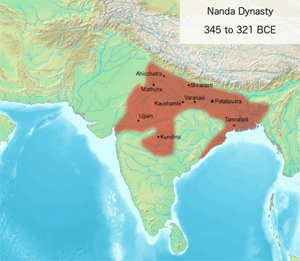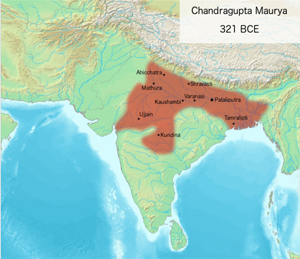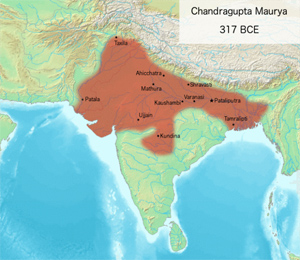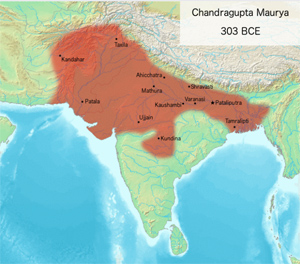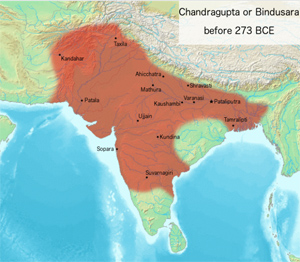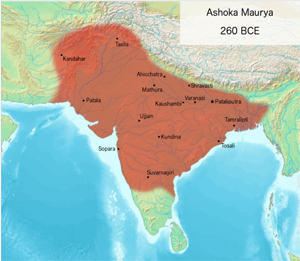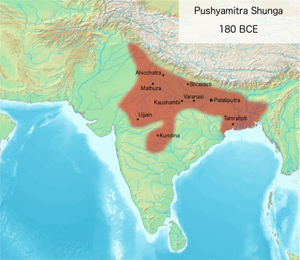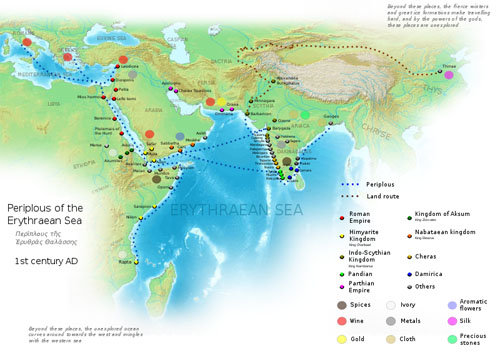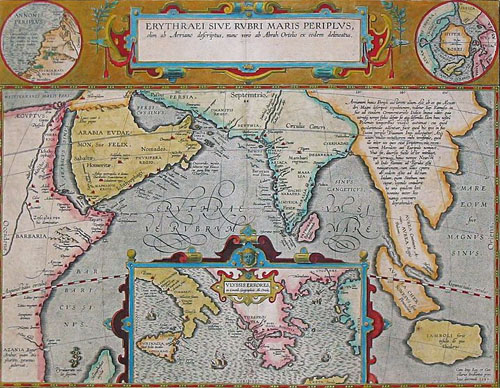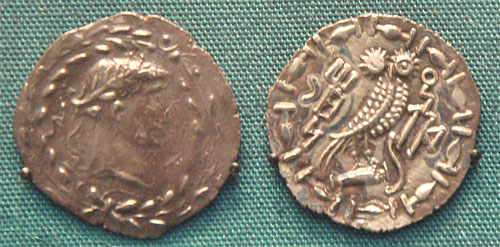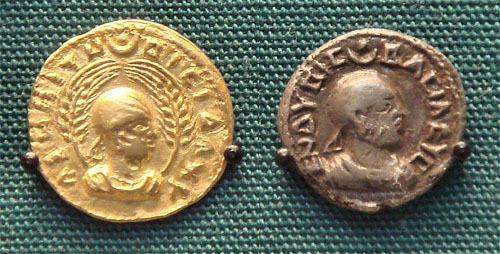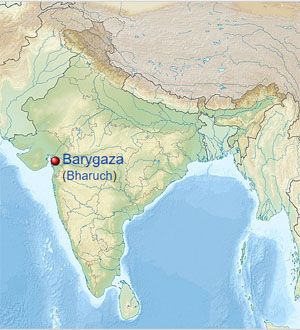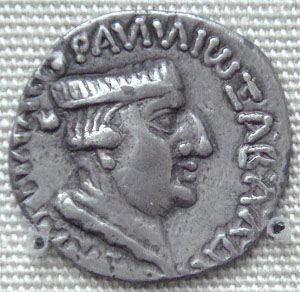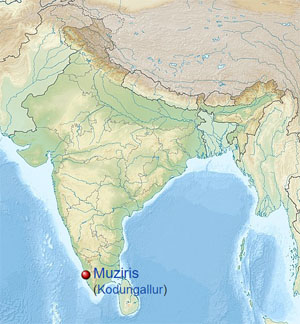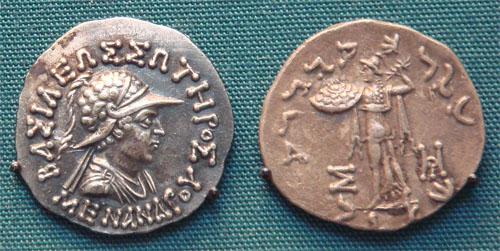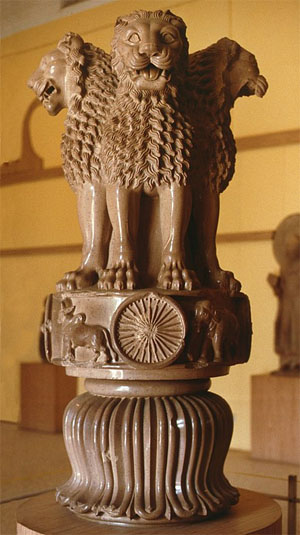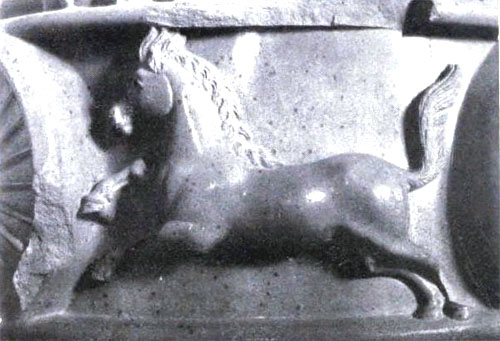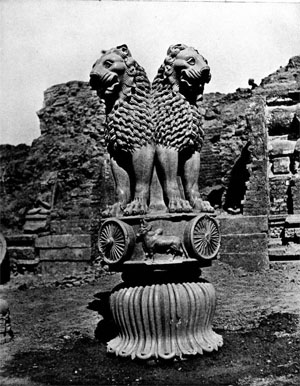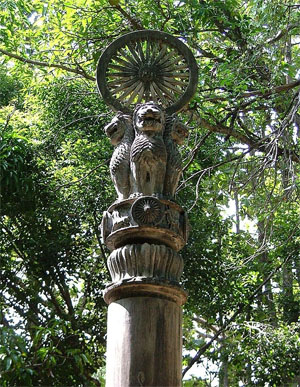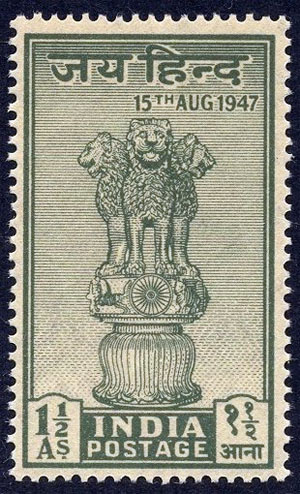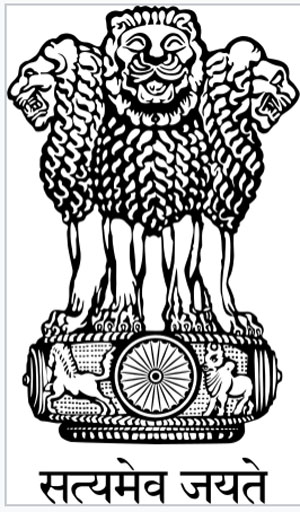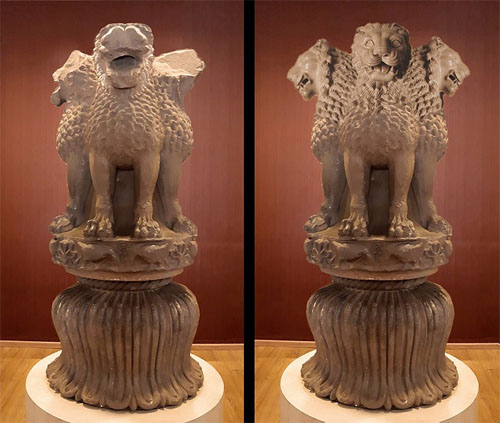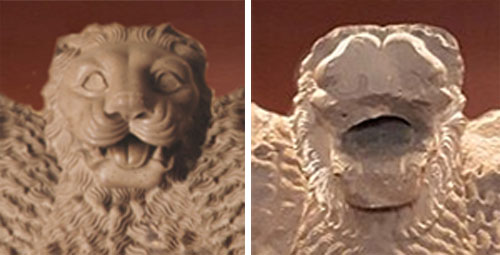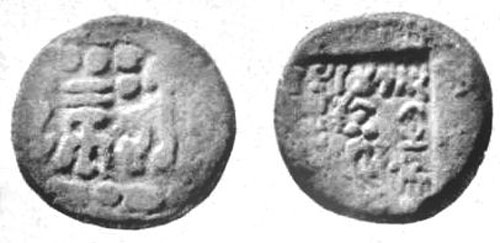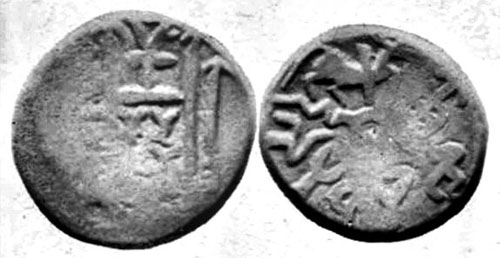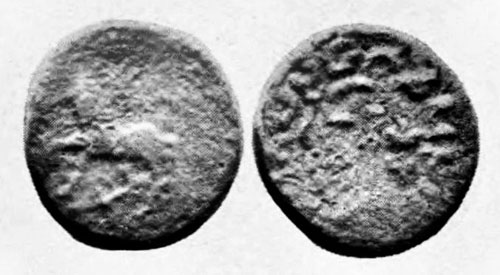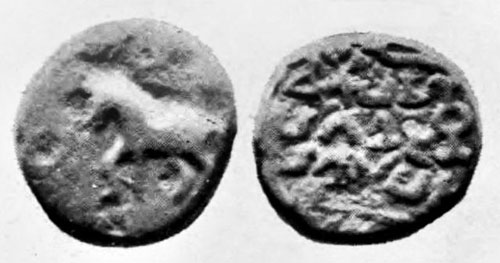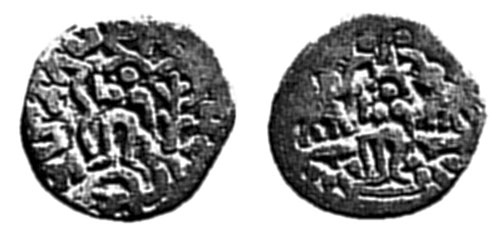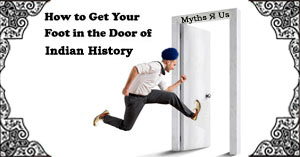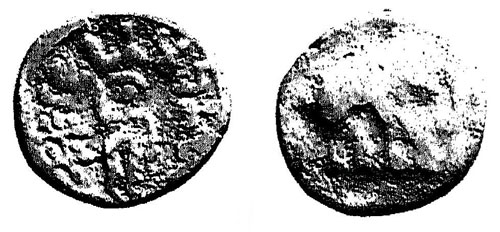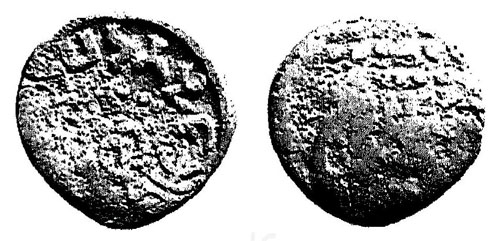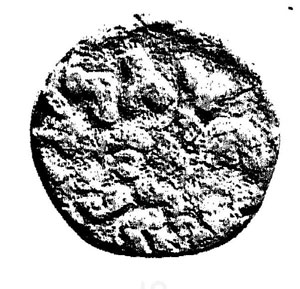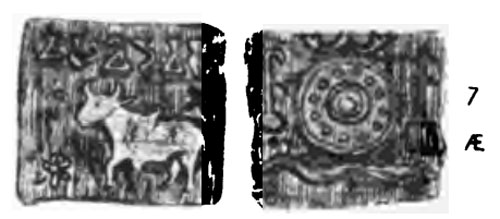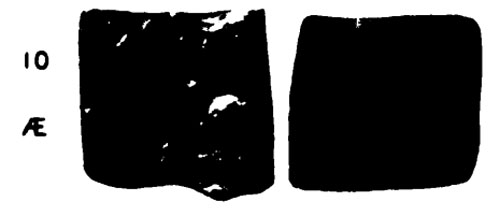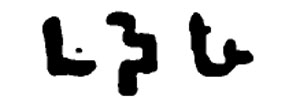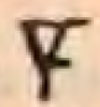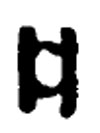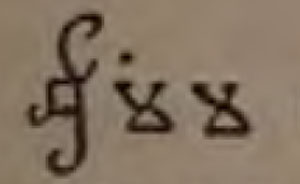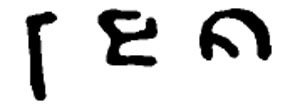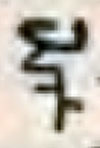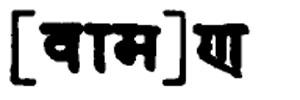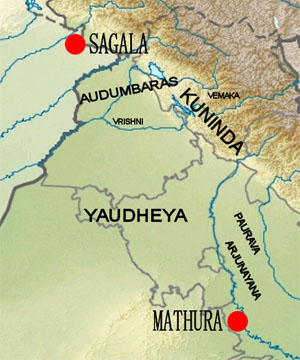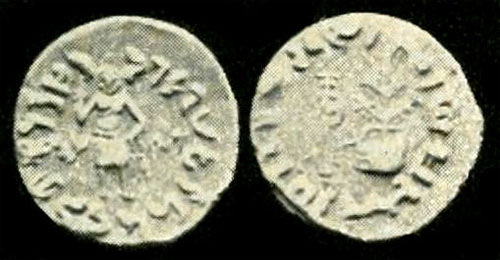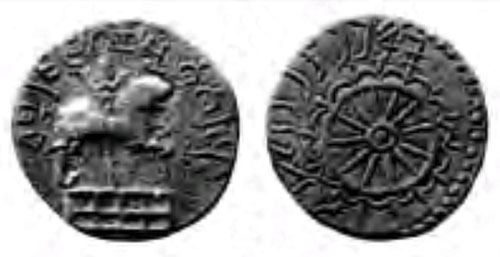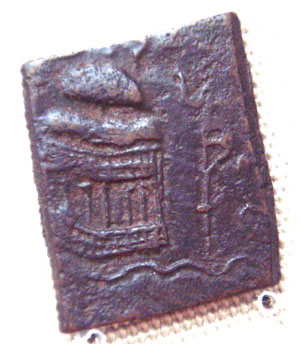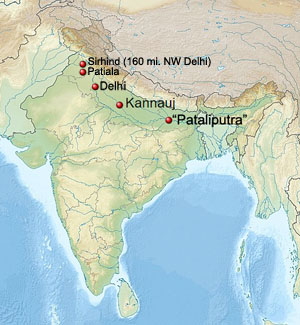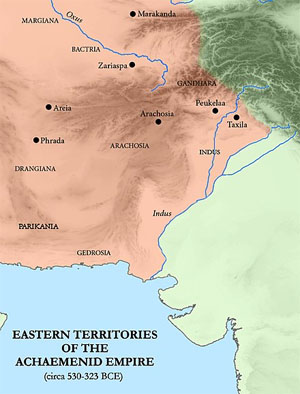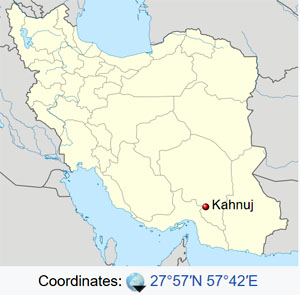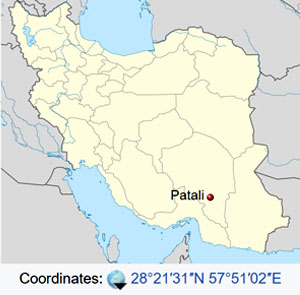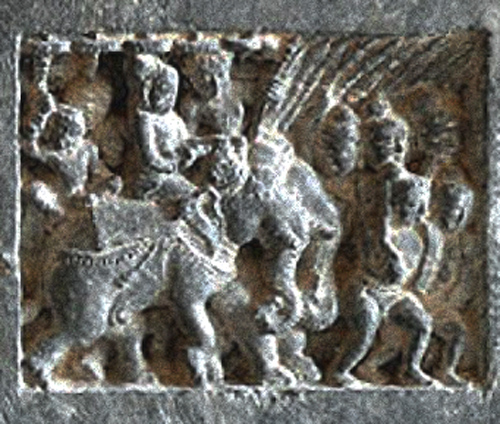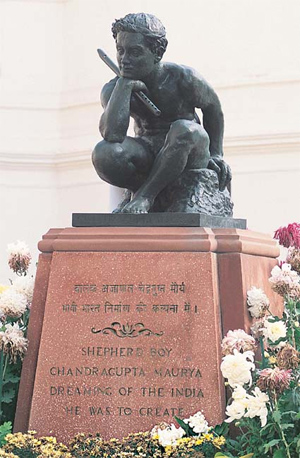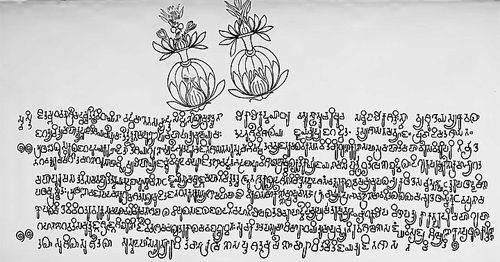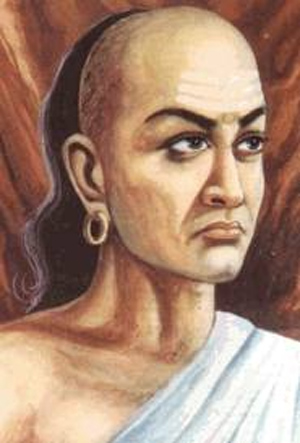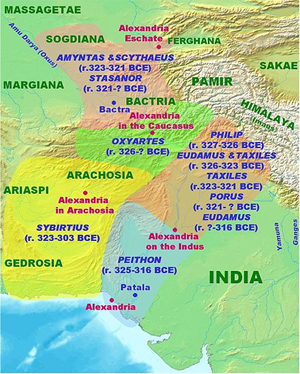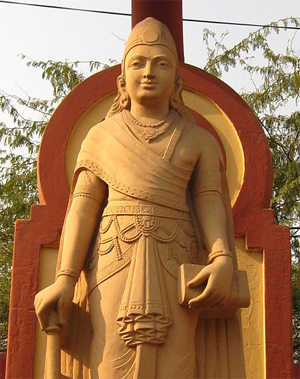by Wikipedia
Accessed: 5/26/21
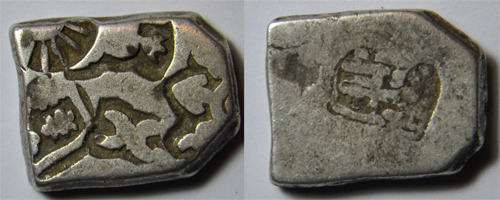
A silver coin of 1 karshapana of the Maurya empire, period of Bindusara Maurya about 297-273 BC, workshop of Pataliputra. Obv: Symbols with a Sun Rev: Symbol Dimensions: 14 x 11 mm Weight: 3.4 g.
2nd Mauryan emperor
Reign: c. 297 – c. 273 BCE
Coronation: c. 297 BCE
Predecessor: Chandragupta Maurya (father)
Successor: Ashoka (son)
Died: c. 273 BCE
Issue: Susima, Ashoka, Dhrupad, Vitashoka, and 98 sons (according to mahawansa)
Dynasty: Maurya
Father: Chandragupta Maurya
Mother: Durdhara (according to Jain tradition)
Bindusara (r. c. 297 – c. 273 BCE), also Amitraghāta or Amitrakhāda (Sanskrit for "slayer of enemies" or “devourer of enemies”) [1][2] or Amitrochates (Greek: Ἀμιτροχάτης)[2] was the second Mauryan emperor of India.
"Strabo (p. 70) says, 'Generally speaking, the men who have hitherto written on the affairs of India were a set of liars, — Deimachos holds the first place in the list, Megasthenes comes next; while Onesikritos and Nearchos, with others of the same class, manage to stammer out a few words (of truth). Of this we became the more convinced whilst writing the history of Alexander. No faith whatever can be placed in Deimachos and Megasthenes. They coined the fables concerning men with ears large enough to sleep in, men without any mouths, without noses, with only one eye, with spider legs, and with fingers bent backward. They renewed Homer's fables concerning the battles of the cranes and pygmies, and asserted the latter to be three spans high. They told of ants digging for gold, and Pans with wedge-shaped heads, of serpents swallowing down oxen and stags, horns and all, — meantime, as Eratosthenes has observed, accusing each other of falsehood. Both of these men were sent as ambassadors to Palimbothra, — Megasthenes to Sandrokottos, Deimachos to Amitrochados his son, — and such are the notes of their residence abroad, which I know not why, they thought fit to leave.
-- Ancient India as Described by Megasthenes and Arrian; Being a Translation of the Fragments of the Indika of Megasthenes Collected by Dr. Schwanbeck, and of the First Part of the Indika of Arrian, by J.W. McCrindle, M.A.
... called by Strabo Allitrochades, and by Athenaios (xiv. 67), Amitrochates,1 [The passage states that Amitrochates, the king of the Indians, wrote to Antiochos asking that king to buy and send him sweet wine, dried figs, and a sophist; and that Antioches replied: We shall send you the figs and the wine, but in Greece the laws forbid a sophist to be sold. Athenaios quotes Hegesander as his authority.]
-- The Invasion of India by Alexander the Great as described by Arrian Q. Curtius Diodorus Plutarch and Justin: Being Translations of Such Portions of the Works of These and Other Classical Authors as Describe Alexander's Campaigns in Afghanistan the Panjab Sindh Gedrosia and Karmania With An Introduction Containing a Life of Alexander Copious Notes Illustrations Maps and Indices, by J.W. McCrindle M.A., Late Principal of the Government College Patna and Fellow of the Calcutta University Member of the General Council of the University of Edinburgh
Ath. 14.67
Athenaeus, The Deipnosophists
C. D. Yonge, B.A., Ed.
Now with respect to dried figs. Those which came from Attica were always considered a great deal the best. Accordingly Dinon, in his History of Persia, says—“And they used to serve up at the royal table all the fruits which the earth produces as far as the king's dominions extend, being brought to him from every district as a sort of first-fruits. And the first king did not think it becoming for the kings either to eat or drink anything which came from any foreign country; and this idea gradually acquired the force of a law. For once, when one of the eunuchs brought the king, among the rest of the dishes at dessert, some Athenian dried figs, the king asked where they came from. And when he heard that they came from Athens, he forbade those who had bought them to buy them for him any more, until it should be in his power to take them whenever he chose, and not to buy them. And it is said that the eunuch did this on purpose, with a view to remind him of the expedition against Attica.” And Alexis, in his Pilot, says—Then came in figs, the emblem of fair Athens,
And bunches of sweet thyme.
And Lynceus, in his epistle to the comic poet, Posidippus, says—“In the delineation of the tragic passions, I do not think that Euripides is at all superior to Sophocles, but in dried figs, I do think that Attica is superior to every other country on earth.” And in his letter to Diagoras, he writes thus:—"But this country opposes to the Chelidonian dried figs those which are called Brigindaridæ, which in their name indeed are barbarous, but which in delicious flavour are not at all less Attic than the others. And Phœnicides, in his Hated Woman, says—They celebrate the praise of myrtle-berries,
Of honey, of the Propylæa, and of figs;
Now these I tasted when I first arrived,
And saw the Propylæa; yet have I found nothing
Which to a woodcock can for taste compare.
In which lines we must take notice of the mention of the [p. 1044] woodcock. But Philemon, in his treatise on Attic Names, says that “the most excellent dried figs are those called Aegilides; and that Aegila is the name of a borough in Attica, which derives its name from a hero called Aegilus; but that the dried figs of a reddish black colour are called Chelidonians.” Theopompus also, in the Peace, praising the Tithrasian figs, speaks thus—Barley cakes, cheesecakes, and Tithrasian figs.
But dried figs were so very much sought after by all men, (for really, as Aristophanes says—There's really nothing nicer than dried figs;)
that even Amitrochates, the king of the Indians, wrote to Antiochus, entreating him (it is Hegesander who tells this story) to buy and send him some sweet wine, and some dried figs, and a sophist; and that Antiochus wrote to him in answer, "The dried figs and the sweet wine we will send you; but it is not lawful for a sophist to be sold in Greece. The Greeks were also in the habit of eating dried figs roasted, as Pherecrates proves by what he says in the Corianno, where we find—But pick me out some of those roasted figs.
And a few lines later he says—Will you not bring me here some black dried figs
Dost understand? Among the Mariandyni,
That barbarous tribe, they call these black dried figs
Their dishes.
I am aware, too, that Pamphilus has mentioned a kind of dried figs, which he calls προκνίδες.
-- Athenaeus. The Deipnosophists. Or Banquet Of The Learned Of Athenaeus. London. Henry G. Bohn, York Street, Covent Garden. 1854.
"Amitrochates," Excerpt from Journal of the Royal Asiatic Society
Volume 41, Issue 2, pp. 423-426
April 1909
AMITROCHATES
In the course of determining the exact date of Buddha's death, Dr. Fleet1 [JRAS., 1909, p. 24.] has adopted as the Sanskrit equivalent of Amitrochates or Amitrochades, the Greek version of the name or title by which they knew Candragupta's [Sandrocottus's !!!] son, Amitrakhada, rather than the conventional Amitraghata,2 [For the variants of the name, cf. Vincent Smith, Early History of India,2, p. 138; the identification with Amitraghata was made by Lassen. See also Franke, Pali und Sanskrit, p. 71.] on the ground that this word has not yet been established as a personal name by any Indian or Ceylonese books or inscriptions, while Amitrakhada is found as an epithet of Indra.
Now it is clear that the Greek version may quite well represent either of these names, and that any choice between them must rest on their intrinsic merits, which seem to me to tell very much in favour of Amitraghata. It is true that Amitrakhada is found in RV., x, 152, 1, and A V. (Paipp.), i, 20, 4,3 [The ordinary recension has amitrasahah instead. The use of hanyate in the next half-verse is noteworthy (na yasya hanyate sakha na jiyate kada cana).] and Vrtrakhada in three passages, RV., iii, 45, 2 (= Samaveda, ii, 1069); 51, 9, which is cited, and khada explained as anta in Aitareya Brahmana, v, 10, 12; and x, 65, 10. In the former instances the epithet applies to Indra, and in the latter to Brhaspati, who has no doubt borrowed it from Indra.4 [Cf. Macdonell, Vedic Mythology, p. 103; Hopkins, Religions of India, p. 136.]
These passages prove beyond doubt that in the received text of the Rgveda Samhita, Amitrakhada and Vrtrakhada had obtained entrance as epithets of Indra. But it will be ...
In Classical sources Bindusara is known as Amitrochates, which appears to be a Greek version of the Sanskrit amitrakhada (eater of foes) or amitraghata (slayer of foes). [Strabo, II, Fragment 29, p. 70.) Strabo refers to Deimachus being sent by Antiochus I as his ambassador to Amitrochates the son of Sandrocottus. Pliny speaks of another envoy who was sent by the king of Egypt, Ptolemy II Philadelphus (185-247 B.C.). [Hist. Nat., Book IV, c. 17, (21).] ... Atheneus of the third century A.D. writes that according to Hegesander, Amitrochates wrote to Antiochus I of Syria and asked for some sweet wine, dried figs, and a sophist to be sent to the Indian court. [Atheneus, III, 444 and XIV, 652-3.)]
Early Buddhist sources do not have much to say on Bindusara. This may have been due to the king's lack of enthusiasm about Buddhism ...
-- Asoka and the Decline of the Mauryas, by Romila Thapar
Chandra-Gupta appears to have agreed on his part to furnish Seleucus annually with fifty elephants; for we read of Antiochus the Great going to India, to renew the alliance with king Sophagasemus, and of his receiving fifty elephants from him. Sophagasemus, I conceive, to be a corruption of Shivaca-Sena, the grandson of Chandra-Gupta. In the puranas this grandson is called Asecavard-dhana or full of mercy, a word of nearly the same import as Aseca-sena or Shivaca-sena; the latter signifying he whose armies are merciful do not ravage and plunder the country.
The son of Chandra-Gupta is called Allitrochates and Amitrocates by the Greek historian.
Seleucus sent an ambassador to him; and after his death the same good intelligence was maintained by Antiochus the son or the grandson of Seleucus. This son of Chandra-Gupta is called Varisara in the puranas; according to Parasara, his name was Dasaratha; but neither the one nor the other bear any affinity to Amitrocates: this name appears, however, to be derived from the Sanscrit Mitra-Gupta, which signifies saved by Mitra or the Sun, and therefore probably was only a surname.
-- On the Chronology of the Hindus, by Captain Francis Wilford, Asiatic Researches, Vol. V, P. 241, 1799
He was the son of the dynasty's founder Chandragupta and the father of its most famous ruler Ashoka. Bindusara's life is not documented as well as the lives of these two emperors: much of the information about him comes from legendary accounts written several hundred years after his death.
Bindusara consolidated the empire created by his father. The 16th century Tibetan Buddhist author Taranatha credits his administration with extensive territorial conquests in southern India, but some historians doubt the historical authenticity of this claim.
Background
Ancient and medieval sources have not documented Bindusara's life in detail. Much of the information about him comes from Jain legends focused on Chandragupta and the Buddhist legends focused on Ashoka. The Jain legends, such as Hemachandra's Parishishta-Parvan were written more than a thousand years after his death.[3] Most of the Buddhist legends about Ashoka's early life also appear to have been composed by Buddhist writers who lived several hundred years after Ashoka's death, and are of little historical value.[4] While these legends can be used to make several inferences about Bindusara's reign, they are not entirely reliable because of the close association between Ashoka and Buddhism.[3]
Buddhist sources that provide information about Bindusara include Divyavadana (including Ashokavadana and Pamsupradanavadana), Dipavamsa, Mahavamsa, Vamsatthappakasini (also known as Mahvamsa Tika or "Mahavamsa commentary"), Samantapasadika, and the 16th century writings of Taranatha.[5][6][7] The Jain sources include the 12th century Parishishta-Parvan by Hemachandra and the 19th century Rajavali-Katha by Devachandra.[8][9] The Hindu Puranas also mention Bindusara in their genealogies of Mauryan rulers.[10] Some Greek sources also mention him by the name "Amitrochates" or its variations.[11][8]
Early life
Parents
Bindusara was born to Chandragupta, the founder of the Mauryan Empire. This is attested by several sources, including the various Puranas and the Mahavamsa.[12]
The Dipavamsa, on the other hand, names Bindusara as the son of the king Shushunaga.[5]
Shishunaga (c. 413 – 395 BCE) was the founder of the Shishunaga dynasty of the Magadha Empire in the present day northern India. Initially, he was an amatya (official) of the Magadha empire under the Haryanka dynasty. He was placed on the throne by the people who revolted against the Haryanka dynasty rule. The Puranas tell us that he placed his son at Varanasi and himself ruled from Girivraja (Rajagriha). He was succeeded by his son Kalashoka (Kakavarna).
-- Shishunaga, by Wikipedia
The prose version of Ashokavadana states that Bindusara was the son of Nanda and a 10th-generation descendant of Bimbisara. Like Dipavamsa, it omits Chandragupta's name altogether. The metrical version of Ashokavadana contains a similar genealogy with some variations.[5]
Chandragupta had a marriage alliance with the Seleucids, which has led to speculation that Bindusara's mother might have been Greek or Macedonian. However, there is no evidence of this.[13] According to the 12th century Jain writer Hemachandra's Parishishta-Parvan, the name of Bindusara's mother was Durdhara.[9]
Names
The name "Bindusara", with slight variations, is attested by the Buddhist texts such as Dipavamsa and Mahavamsa ("Bindusaro"); the Jain texts such as Parishishta-Parvan; as well as the Hindu texts such as Vishnu Purana ("Vindusara").[14][15] Other Puranas give different names for Chandragupta's successor; these appear to be clerical errors.[14] For example, the various recensions of Bhagavata Purana mention him as Varisara or Varikara. The different versions of Vayu Purana call him Bhadrasara or Nandasara.[10]
The Mahabhashya ...
The Mahābhāṣya, "great commentary"), attributed to Patañjali, is a commentary on selected rules of Sanskrit grammar from Pāṇini's treatise, the Aṣṭādhyāyī, as well as Kātyāyana's Vārttika-sūtra, an elaboration of Pāṇini's grammar....The dating of Patanjali and his Mahabhasya is established by...evidence...from the Maurya Empire period, the historical events mentioned in the examples he used to explain his ideas.
-- Patanjali, by Wikipedia
... names Chandragupta's successor as Amitra-ghata (Sanskrit for "slayer of enemies").[6] The Greek writers Strabo and Athenaeus call him Allitrochades and Amitrochates respectively; these names are probably derived from the Sanskrit title. In addition, Bindusara was given the title Devanampriya ("The Beloved of the Gods"), which was also applied to his successor Ashoka.[2] The Jain work Rajavali-Katha states that his birth name was Simhasena.[8]
In the course of determining the exact date of Buddha's death, Dr. Fleet [JRAS., 1909, p. 24.] has adopted as the Sanskrit equivalent of Amitrochates or Amitrochades, the Greek version of the name or title by which they knew Candragupta's [Sandrocottus's !!!] son, Amitrakhada, rather than the conventional Amitraghata, [For the variants of the name, cf. Vincent Smith, Early History of India, 2, p. 138; the identification with Amitraghata was made by Lassen. See also Franke, Pali und Sanskrit, p. 71.] on the ground that this word has not yet been established as a personal name by any Indian or Ceylonese books or inscriptions, while Amitrakhada is found as an epithet of Indra.
-- "Amitrochates," Excerpt from Journal of the Royal Asiatic Society, Volume 41, Issue 2, pp. 423-426, April 1909
Both Buddhist and Jain texts mention a legend about how Bindusara got his name. Both accounts state that Chandragupta's minister Chanakya used to mix small doses of poison in the emperor's food to build his immunity against possible poisoning attempts. One day, Chandragupta, not knowing about the poison, shared his food with his pregnant wife. According to the Buddhist legends (Mahavamsa and Mahavamsa Tikka), the queen was seven days away from delivery at this time. Chanakya arrived just as the queen ate the poisoned morsel. Realizing that she was going to die, he decided to save the unborn child. He cut off the queen's head and cut open her belly with a sword to take out the foetus. Over the next seven days, he placed the foetus in the belly of a goat freshly killed each day. After seven days, Chandragupta's son was "born". He was named Bindusara, because his body was spotted with drops ("bindu") of goat's blood.[16] The Jain text Parishishta-Parvan names the queen as Durdhara, and states that Chanakya entered the room the very moment she collapsed. To save the child, he cut open the dead queen's womb and took the baby out. By this time, a drop ("bindu") of poison had already reached the baby and touched its head. Therefore, Chanakya named him Bindusara, meaning "the strength of the drop".[9]
Family
The prose version of Ashokavadana names three sons of Bindusara: Sushima, Ashoka and Vigatashoka. The mother of Ashoka and Vigatashoka was a woman named Subhadrangi, the daughter of a Brahmin of the Champa city. When she was born, an astrologer predicted that one of her sons would be a king, and the other a religious man. When she grew up, her father took her to Bindusara's palace in Pataliputra. Bindusara's wives, jealous of her beauty, trained her as the royal barber. Once, when the Emperor was pleased with her hairdressing skills, she expressed her desire to be a queen. Bindusara was initially apprehensive about her low class, but made her the chief queen after learning about her Brahmin descent. The couple had two sons: Ashoka and Vigatashoka. Bindusara did not like Ashoka because his "limbs were hard to the touch".[17]
Another legend in Divyavadana names Ashoka's mother as Janapadakalyani.[18] According to the Vamsatthappakasini (Mahavamsa Tika), the name of Ashoka's mother was Dhamma.[19] The Mahavamsa states that Bindusara had 101 sons from 16 women. The eldest of these was Sumana, and the youngest was Tishya (or Tissa). Ashoka and Tishya were born to the same mother.[12]
Reign
Historian Upinder Singh estimates that Bindusara ascended the throne around 297 BCE.[6]
Territorial conquests
The 16th century Tibetan Buddhist author Taranatha states that Chanakya, one of Bindusara's "great lords", destroyed the nobles and kings of 16 towns and made him master of all the territory between the western and the eastern seas (Arabian Sea and the Bay of Bengal). According to some historians, this implies conquest of Deccan by Bindusara, while others believe that this only refers to suppression of revolts.[6]
Sailendra Nath Sen notes that the Mauryan empire already extended from the western sea (beside Saurashtra) to the eastern sea (beside Bengal) during Chandragupta's reign. Besides, Ashoka's inscriptions found in southern India do not mention anything about Bindusara's conquest of Deccan (southern India). Based on this, Sen concludes that Bindusara did not extend the Mauryan empire, but managed to retain the territories he inherited from Chandragupta.[20]
K. Krishna Reddy, on the other hand, argues that Ashoka's inscriptions would have boasted about his conquest of southern India, had he captured Deccan. Reddy, therefore, believes that the Mauryan empire extended up to Mysore during Bindusara's reign. According to him, the southernmost kingdoms were not a part of the Mauryan empire, but probably acknowledged its suzerainty.[21]
Alain Daniélou believes that Bindusara inherited an empire that included the Deccan region, and made no territorial additions to the empire. Daniélou, however, believes that Bindusara brought the southern territories of the Cheras, the Cholas and the Satyaputras under nominal Mauryan control, although he could not overcome their armies. His theory is based on the fact that the ancient Tamil literature alludes to Vamba Moriyar (Mauryan conquest), although it does not provide any details about the Mauryan expeditions. According to Daniélou, Bindusara's main achievement was organization and consolidation of the empire he inherited from Chandragupta.[22]
Territorial evolution of Magadha and the Maurya Empire between 600 and 180 BCE, including possible expansion under Bindusara prior to 273 BCE.
Magadha (pre-expansion) c. 600 BCE
Bimbisara c. 500 or 400 BCE
Ajatashatru c. 460 or 380 BCE
Shishunaga Dynasty before 345 BCE
Nanda Dynasty 345 to 321 BCE
Chandragrupta Maurya 321 BCE
Chandragrupta Maurya 317 BCE
Chandragrupta Maurya 303 BCE
Chandragrupta or Bindusara before 273 BCE
Ashoka Maurya 260 BCE
Pushyamitra Shunga 180 BCE
Takshashila revolt
The Mahavamsa suggests that Bindusara appointed his son Ashoka as the viceroy of Ujjayini.[12] Ashokavadana states that Bindusara sent Ashoka to lay siege to Takshashila. The Emperor refused to provide any weapons or chariots for Ashoka's expedition. The devatas (deities) then miraculously brought him soldiers and weapons. When his army reached Takshashila, the residents of the city approached him. They told him that they only opposed Bindusara's oppressive ministers; they had no problem with the Emperor or the prince. Ashoka then entered the city without opposition, and the devatas declared that he would rule the entire earth one day. Shortly before Bindusara's death, there was a second revolt in Takshashila. This time, Sushima was sent to quell the rebellion, but he failed in the task.[17]
Ministers
The Rajavali-Katha states that Chandragupta's prime minister Chanakya accompanied him to the forest for retirement, after handing over the administration to Bindusara.[23] However, the Parishishta-Parvan states that Chanakya continued to be Bindusara's prime minister. It mentions a legend about Chanakya's death: Chanakya asked the emperor to appoint a man named Subandhu as one of his ministers. However, Subandhu wanted to become a higher minister and grew jealous of Chanakya. So, he told Bindusara that Chanakya had cut open the belly of his mother. After confirming the story with the nurses, Bindusara started hating Chanakya. As a result, Chanakya, who was already a very old man by this time, retired and decided to starve himself to death. Meanwhile, Bindusara came to know about the detailed circumstances of his birth, and implored Chanakya to resume his ministerial duties. When Chanakya refused to oblige, the Emperor ordered Subandhu to pacify him. Subandhu, while pretending to appease Chanakya, burned him to death. Shortly after this, Subandhu himself had to retire and become a monk due to Chanakya's curse.[9][24]
Ashokavadana suggests that Bindusara had 500 royal councillors. It names two officials – Khallataka and Radhagupta – who helped his son Ashoka became the emperor after his death.[17]
Foreign relations
Bindusara maintained friendly diplomatic relations with the Greeks. Deimachos of Plateia was the ambassador of Seleucid emperor Antiochus I at Bindusara's court.[25][20][26] Deimachos seems to have written a treatise entitled "On Piety" (Peri Eusebeias).[27] The 3rd century Greek writer Athenaeus, in his Deipnosophistae, mentions an incident that he learned from Hegesander's writings: Bindusara requested Antiochus to send him sweet wine, dried figs and a sophist.[11] Antiochus replied that he would send the wine and the figs, but the Greek laws forbade him to sell a sophist.[28][29][30] Bindusara's request for a sophist probably reflects his intention to learn about the Greek philosophy.[31]
Diodorus states that the king of Palibothra (Pataliputra, the Mauryan capital) welcomed a Greek author, Iambulus. This king is usually identified as Bindusara.[20] Pliny states that the Egyptian king Philadelphus sent an envoy named Dionysius to India.[31][32] According to Sailendra Nath Sen, this appears to have happened during Bindusara's reign.[20]
Religion
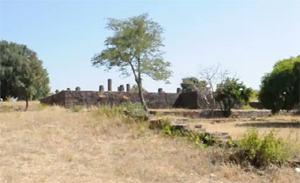
An inscription at Temple 40 in Sanchi suggests Bindusura may have been connected to its construction and to Buddhism.[33] 3rd century BCE
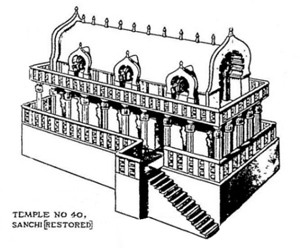
Conjectural reconstruction of timber-built Temple 40 in Sanchi.
The Buddhist texts Samantapasadika and Mahavamsa suggest that Bindusara followed Brahmanism, calling him a "Brahmana bhatto" ("votary of the Brahmanas").[7][34] According to the Jain sources, Bindusara's father Chandragupta adopted Jainism before his death. However, they are silent on Bindusara's faith, and there is no evidence to show that Bindusara was a Jain.[35] A fragmentary inscription at Sanchi, in the ruins of the 3rd century BCE Temple 40, perhaps refers to Bindusara, which might suggest his connection with the Buddhist order at Sanchi.[6][33]
Some Buddhist texts mention that an Ajivika astrologer or priest at Bindusara's court prophesied the future greatness of the prince Ashoka.[36] The Pamsupradanavadana (part of Divyavadana) names this man as Pingalavatsa.[37] The Vamsatthappakasini (the Mahavamsa commentary) names this man as Janasana, based on a commentary on Majjhima Nikaya.[7]
The Divyavadana version states that Pingalavatsa was an Ajivika parivrajaka (wandering teacher). Bindusara asked him to assess the ability of the princes to be the next emperor, as the two watched the princes play. Pingalavatsa recognized Ashoka as the most suitable prince, but did not give a definitive answer to the Emperor, since Ashoka was not Bindusara's favourite son. He, however, told Queen Subhadrangi of Ashoka's future greatness. The Queen requested him to leave the kingdom before the Emperor forced him to provide an answer. Pingalavatsa returned to the court after Bindusara's death.[36]
The Mahavamsa commentary states that Janasana (also Jarasona or Jarasana) was the Queen's kulupaga (ascetic of the royal household). He had been born as a python during the period of Kassapa Buddha, and had become very wise after listening to the discussions of the bhikkhus. Based on his observations of the Queen's pregnancy, he prophesied Ashoka's future greatness. He appears to have left the court for unknown reasons. When Ashoka grew up, the Queen told him that Janasana had forecast his greatness. Ashoka then sent a carriage to bring back Janasana, who was residing at an unnamed place far from the capital, Pataliputra. On the way back to Pataliputra, he was converted to Buddhism by one Assagutta.[36]
Based on these legends, scholars such as A. L. Basham conclude that Bindusara patronized the Ajivikas.[36][6]
Death and succession
Historical evidence suggests that Bindusara died in the 270s BCE. According to Upinder Singh, Bindusara died around 273 BCE.[6] Alain Daniélou believes that he died around 274 BCE.[22] Sailendra Nath Sen believes that he died around 273-272 BCE, and that his death was followed by a four-year struggle of succession, after which his son Ashoka became the emperor in 269-268 BCE.[20]
According to the Mahavamsa, Bindusara reigned for 28 years, while according to the Puranas, he ruled for 25 years.[38] The Buddhist text Manjushri-Mula-Kalpa claims that he ruled for 70 years, which is not historically accurate.[39]
All sources agree that Bindusara was succeeded by his son Ashoka, although they provide varying descriptions of the circumstances of this succession. According to the Mahavamsa, Ashoka had been appointed as the viceroy of Ujjain. On hearing about his father's fatal illness, he rushed to the capital, Pataliputra. There, he killed his 99 brothers (leaving only Tishya), and became the new emperor.[12]
According to the prose version of Ashokavadana, Bindusara's favourite son Sushima once playfully threw his gauntlet at the prime minister, Khallataka. The minister thought that Sushima was unworthy of being an emperor. Therefore, he approached the 500 royal councillors, and suggested appointing Ashoka as the emperor after Bindusara's death, pointing out that the devatas had predicted his rise as the universal ruler. Sometime later, Bindusara fell sick and decided to hand over the administration to his successor. He asked his ministers to appoint Sushima as the emperor, and Ashoka as the governor of Takshashila. However, by this time, Sushima had been sent to Takshashila, where he was unsuccessfully trying to quell a rebellion. When the Emperor was on his deathbed, the ministers suggested appointing Ashoka as the temporary emperor, and re-appointing Sushima as the emperor after his return from Takshashila. However, Bindusara became angry when he heard this suggestion. Ashoka then declared that if he was meant to be Bindusara's successor, the devatas would appoint him as the emperor. The devatas then miraculously placed the royal crown on his head, while Bindusara died. When Sushima heard this news, he advanced towards Pataliputra to claim the throne. However, he died after being tricked into a pit of burning charcoal by Ashoka's well-wisher Radhagupta.[17][3]
The Rajavali-Katha states that Bindusara retired after handing over the throne to Ashoka.[23]
References
1. Chattopadhyaya, Sudhakar (1977). Bimbisāra to Aśoka: With an Appendix on the Later Mauryas. Roy and Chowdhury. p. 98.
2. "According to the Jaina and the Buddhist traditions Chandragupta had many sons and Bindusara was chosen to succeed him. He also had the title 'Devanampriya'. The Greeks call him Amitrachates, the Sanskrit equivalent of Amitragatha" Murthy, H. V. Sreenivasa (1963). A History of Ancient India. Bani Prakash Mandir. p. 120.
3. Singh 2008, p. 331-332.
4. Srinivasachariar 1974, pp. lxxxvii-lxxxviii.
5. Srinivasachariar 1974, p. lxxxviii.
6. Singh 2008, p. 331.
7. S. M. Haldhar (2001). Buddhism in India and Sri Lanka (c. 300 BC to C. 600 AD). Om. p. 38. ISBN 9788186867532.
8. Daniélou 2003, p. 108.
9. Motilal Banarsidass (1993). "The Minister Cāṇakya, from the Pariśiṣtaparvan of Hemacandra". In Phyllis Granoff (ed.). The Clever Adulteress and Other Stories: A Treasury of Jaina Literature. Translated by Rosalind Lefeber. pp. 204–206. ISBN 9788120811508.
10. Guruge 1993, p. 465.
11. Kosmin 2014, p. 35.
12. Srinivasachariar 1974, p. lxxxvii.
13. Arthur Cotterell (2011). The Pimlico Dictionary of Classical Civilizations. Random House. p. 189. ISBN 9781446466728.
14. Vincent Arthur Smith (1920). Asoka, the Buddhist emperor of India. Oxford: Clarendon Press. pp. 18–19. ISBN 9788120613034.
15. Rajendralal Mitra (1878). "On the Early Life of Asoka". Proceedings of the Asiatic Society of Bengal. Asiatic Society of Bengal: 10.
16. Trautmann, Thomas R. (1971). Kauṭilya and the Arthaśāstra: a statistical investigation of the authorship and evolution of the text. Brill. p. 15.
17. Eugène Burnouf (1911). Legends of Indian Buddhism. New York: E. P. Dutton. pp. 20–29.
18. Singh 2008, p. 332.
19. Sastri 1988, p. 167.
20. Sen 1999, p. 142.
21. K Krishna Reddy (2005). General Studies History. New Delhi: Tata McGraw-Hill. p. A42-43. ISBN 9780070604476.
22. Daniélou 2003, p. 109.
23. B. Lewis Rice (1889). Epigraphia Carnatica, Volume II: Inscriptions and Sravana Belgola. Bangalore: Mysore Government Central Press. p. 9.
24. Hemachandra (1891). Sthavir̂aval̂i charita, or, Pariśishtaparvan. Translated by Hermann Jacobi. Calcutta: Asiatic Society. pp. 67–68.
25. Mookerji, Radhakumud (1966). Chandragupta Maurya and His Times. Motilal Banarsidass. p. 38. ISBN 9788120804050.
26. Talbert, Richard J. A.; Naiden, Fred S. (2017). Mercury's Wings: Exploring Modes of Communication in the Ancient World. Oxford University Press. p. 295. ISBN 9780190663285.
27. Erskine, Andrew (2009). A Companion to the Hellenistic World. John Wiley & Sons. p. 421. ISBN 9781405154413.
28. Mookerji 1988, p. 38.
29. J. C. McKeown (2013). A Cabinet of Greek Curiosities: Strange Tales and Surprising Facts from the Cradle of Western Civilization. Oxford University Press. p. 99. ISBN 9780199982110.
30. Athenaeus (of Naucratis) (1854). The Deipnosophists, or, Banquet of the learned of Athenaeus. III. Literally Translated by C. D. Yonge, B. A. London: Henry G. Bohn. p. 1044. Original Classification Number: 888 A96d tY55 1854. Archived from the original on 31 December 2013.
31. Irfan Habib & Vivekanand Jha 2004, p. 20.
32. India, the Ancient Past, Burjor Avari, p.108-109
33. Singh, Upinder (2016). The Idea of Ancient India: Essays on Religion, Politics, and Archaeology(in Arabic). SAGE Publications India. ISBN 9789351506454.
34. Beni Madhab Barua (1968). Asoka and His Inscriptions. 1. The New Age. p. 171.
35. Kanai Lal Hazra (1984). Royal patronage of Buddhism in ancient India. D.K. p. 58.
36. Basham, A.L. (1951). History and Doctrines of the Ājīvikas (2nd ed.). Luzac & Company. pp. 146–147. ISBN 81-208-1204-2.
37. Guruge 1993, p. 27.
38. Romila Thapar 1961, p. 13.
39. Sudhakar Chattopadhyaya (1977). Bimbisāra to Aśoka: With an Appendix on the Later Mauryas. Roy and Chowdhury. p. 102.
40. Sukanya Verma (24 October 2001). "Asoka". rediff.com. Archived from the original on 24 August 2017.
41. "Happy Birthday Sameer Dharamadhikari", The Times of India, 25 September 2015, archivedfrom the original on 17 May 2017
42. "Avneet Kaur joins 'Chandra Nandni' opposite Siddharth Nigam". ABP Live. 10 August 2017. Archived from the original on 24 August 2017.
Bibliography
• Daniélou, Alain (2003). A Brief History of India. Inner Traditions / Bear & Co. p. 139. ISBN 978-1-59477-794-3.
• Guruge, Ananda W. P. (1993). Aśoka, the Righteous: A Definitive Biography. Central Cultural Fund, Ministry of Cultural Affairs and Information. ISBN 978-955-9226-00-0.
• Kosmin, Paul J. (2014), The Land of the Elephant Kings: Space, Territory, and Ideology in Seleucid Empire, Harvard University Press, ISBN 978-0-674-72882-0
• Mookerji, Radha Kumud (1988) [first published in 1966], Chandragupta Maurya and his times (4th ed.), Motilal Banarsidass, ISBN 81-208-0433-3
• Sastri, K. A. Nilakanta (1988). Age of the Nandas and Mauryas. Motilal Banarsidass. ISBN 9788120804661.
• Sen, Sailendra Nath (1999). Ancient Indian History and Civilization. New Age International. ISBN 9788122411980.
• Singh, Upinder (2008). A History of Ancient and Early Medieval India: From the Stone Age to the 12th Century. Pearson Education India. ISBN 978-81-317-1120-0.
• Srinivasachariar, M. (1974). History of Classical Sanskrit Literature. Motilal Banarsidass. ISBN 9788120802841.
• Irfan Habib; Vivekanand Jha (2004). Mauryan India. A People's History of India. Aligarh Historians Society / Tulika Books. ISBN 978-81-85229-92-8.
• Romila Thapar (1961). Aśoka and the Decline of the Mauryas. Oxford University Press.

